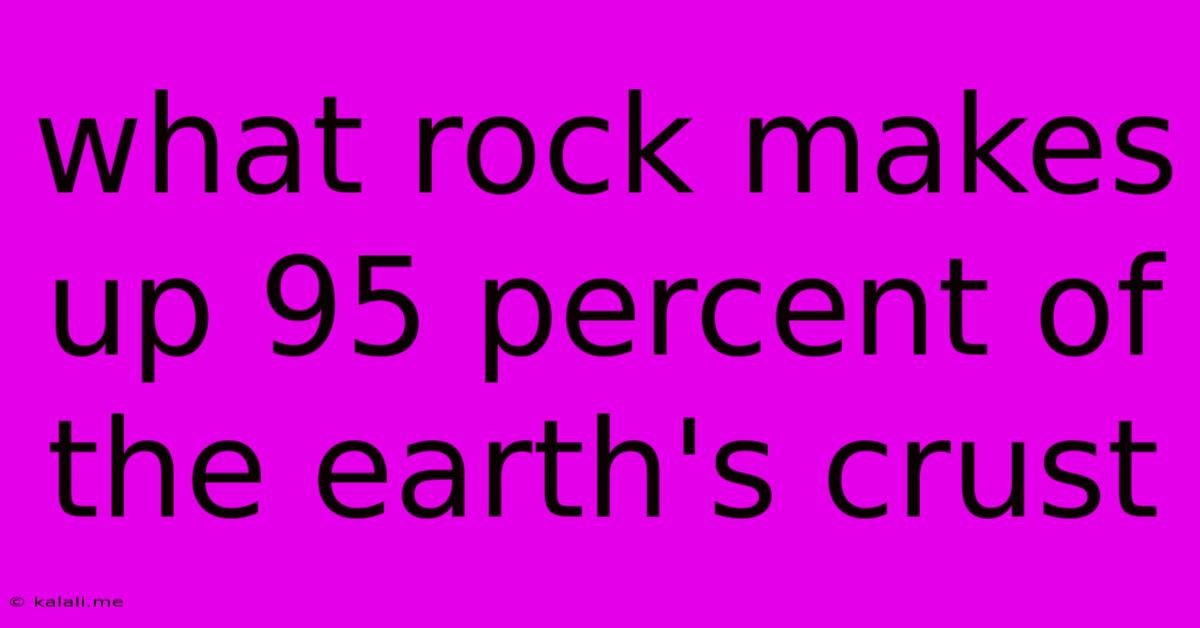What Rock Makes Up 95 Percent Of The Earth's Crust
Kalali
Jun 12, 2025 · 3 min read

Table of Contents
What Rock Makes Up 95 Percent of the Earth's Crust? The Surprising Answer
The Earth's crust, that thin outer shell we call home, is overwhelmingly composed of a single type of rock: igneous rock. While the exact percentage varies depending on the methodology used, it's safe to say that igneous rocks constitute the vast majority – well over 95% – of the Earth's crust. This article delves into the surprising dominance of igneous rocks and explores why this seemingly simple answer holds significant geological implications. Understanding this foundational aspect of our planet is crucial for grasping the processes that shaped our world and continue to influence its evolution.
Igneous Rocks: Forged in Fire
The term "igneous" derives from the Latin word "ignis," meaning fire. This aptly describes the origin of these rocks, formed from the cooling and solidification of molten rock (magma or lava). This process can occur beneath the Earth's surface, creating intrusive igneous rocks like granite, or on the surface, resulting in extrusive igneous rocks like basalt. The difference in cooling rates significantly impacts the texture and mineral composition of the resulting rocks.
-
Intrusive Igneous Rocks: These cool slowly beneath the Earth's surface, allowing large crystals to form, resulting in a coarse-grained texture. Granite, a common example, is often found in mountain ranges and continental crust. Its high silica content contributes to its lighter color and relatively low density.
-
Extrusive Igneous Rocks: These cool rapidly on the Earth's surface, leading to fine-grained textures or even glassy appearances. Basalt, a dark-colored, dense rock, is the most abundant extrusive igneous rock and forms much of the oceanic crust. Its prevalence is a key factor in the overall dominance of igneous rocks.
Why Igneous Rocks are so Prevalent
The Earth's crust is constantly being reshaped by plate tectonics, volcanic activity, and erosion. However, the vast majority of this crust originates from the mantle – the layer beneath the crust. The mantle is primarily composed of molten rock that, through volcanic eruptions and other geological processes, is brought to the surface, solidifying into igneous rocks. This continuous cycle of magma formation, eruption, and solidification is the primary reason igneous rocks dominate the Earth's crustal composition.
While sedimentary and metamorphic rocks are also significant components of the Earth’s surface, they represent relatively smaller portions when considering the overall volume of the Earth's crust. Sedimentary rocks are formed from the accumulation and cementation of sediments, derived from the weathering and erosion of pre-existing rocks. Metamorphic rocks, on the other hand, are formed from the transformation of existing rocks under intense heat and pressure. While crucial for understanding surface geology and providing valuable insights into Earth's history, their overall volume is significantly less than that of igneous rocks.
Beyond the Numbers: Geological Significance
The prevalence of igneous rocks underscores the significant role of magma and volcanic activity in shaping our planet. Their mineral composition provides clues about the chemical makeup of the Earth's mantle and the processes that have shaped the continents and ocean basins. Studying igneous rocks helps geologists understand plate tectonics, the formation of mountain ranges, and the evolution of our planet over billions of years. Understanding the distribution and characteristics of various igneous rocks is fundamental to many geological studies.
In conclusion, while other rock types are vital for understanding Earth’s surface features, igneous rocks, primarily basalt and granite, form the overwhelming majority (over 95%) of the Earth's crust. This foundational truth highlights the crucial role of volcanic processes and the continuous cycle of rock formation and transformation in shaping our planet's geological landscape.
Latest Posts
Latest Posts
-
Transitive Verb And Intransitive Verbs Worksheet
Jun 13, 2025
-
Which Of The Following Is A State Function
Jun 13, 2025
-
Which Of The Following Teachers Best Exemplifies Social Constructivist Thinking
Jun 13, 2025
-
Coefficient Of Linear Expansion Of Concrete
Jun 13, 2025
-
Least Common Multiple Of 28 And 35
Jun 13, 2025
Related Post
Thank you for visiting our website which covers about What Rock Makes Up 95 Percent Of The Earth's Crust . We hope the information provided has been useful to you. Feel free to contact us if you have any questions or need further assistance. See you next time and don't miss to bookmark.